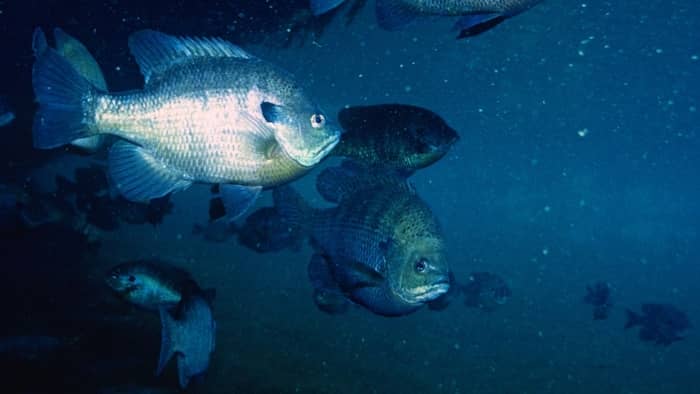Last Updated on January 14, 2022 by Fabiola L.
Perch and Bluegill fish are two species of fish that are commonly confused. Lucky for you, this article will tell you the main differences between SunPerch vs Bluegill.
Perch and Bluegill fish are two species of fish that are commonly confused. Lucky for you, this article will tell you the main differences between Perch vs. Bluegill.
To start, it’s important to note that these two fishes come from different families. The Bluegill is part of the Centrarchidae family. Members of this family have flat and round bodies. In fact, this shape has earned them the nickname of pancake fish.
Some other members of the Centrarchidae family include the Redear Sunfish, Bass, and Crappie. It’s important to know this distinction between families.
On the other hand, the perch belongs to the Percidae family. Some other types of fish in this family include the walleye and darters. This family is very large, containing around 200 different species!
Now let’s go into details of the perch vs bluegill.
What Is A Bluegill?
Bluegill fish are considered an important species in nature because it is food for other influential fish like the Bass. Many departments of natural resources pay special attention to add Bluegills into their freshwater systems every year.
However, the U.S Fish and Wildlife Department says in some cases, countries have experienced a problem with overpopulation of bluegill because they compete for habitat and food with other freshwater fish.
The scientific name of the Bluegill is Lepomis Machrochirus. Known for its perfect size and delicious taste, they have earned the tasty nickname of Panfish.
Bluegills have blue and purple on their face and orange on their belly. A unique characteristic that sets bluegills apart from other sunfish is that they have a black spot on their ear. This dark blue color is located on the tip of the gill and also on the lower end of the jaw.
Bluegills eat insects and larvae that are near the surface of ponds and lakes. Surprisingly, they will also eat a small amount of aquatic plants.
Learn more about: Redear Sunfish Vs Bluegill: The Amazing Differences!
Bluegill Life Cycle
These fish typically breed in late spring once the water’s reach a temperature of at least 70F degrees Fahrenheit. Males will look for a place at the bottom of the waterbed to prepare their nest. This fish is very communal and will lay their nests in clusters with at least 50 others!
The nests are between 2 inches and 6 inches deep. The spawning period for bluegills is quite long and continues all the way into fall.
Male fish dance and swim around the nest to display their most favorable traits. Females will choose which nests are most suitable for their eggs. More than one egg can be laid per nest.
In fact, this is quite common because females are likely to choose the males with the strongest performance.
Bluegills are strong producers and can average about 40,000 eggs per season! A female’s egg carrying capacity increases over time. Eggs take between 2 and 5 days to hatch.
From there, Bluegills can grow quickly. This is especially true if they are provided with the optimum food and habitat conditions. In aquaponics, you have the upper hand in success because you can control the environment.
The main growth period is in the first three years. After that, the fish reach maturity and their growth slows down sufficiently. On average a bluegill can live up to being 9 to 11 years old.
How Big Can Bluegill Get?
In its first years of life, a bluegill grows rapidly. After the tender age of 3, they have reached their peak size of between 6 to 10 inches. At that point, they are weighing out between 1 to 2 pounds.
When stocking your aquaponics tank, be sure to compensate for their growth over time. A beginner’s mistake is to overstock your tank when the fish are young, resulting in an overcrowded tank. This causes a lot of problems for your system including lack of available oxygen and nitrification of your water.
The Main Differences Between SunPerch Vs Bluegill
First off, to make it clear: Sunperch is another name for Perch! The second layer of confusion is being able to determine between a Perch and Bluegill. Paying close attention to details will be the best way for you to make this distinction.
As mentioned before, Perch and Bluegill are NOT in the same family and therefore are not the same fish. However in fishing communities, especially in Texas, they use the name interchangeably which may be the source of confusion.
Perches have thinner and longer bodies. Bluegills are more rounded, like a pan shape (hence their nickname). If you want to be sure to find a true perch, you will have to confirm it came from the Percidae family.
To know if it’s a real perch, you can feel if the fish has rough scales. The most common variety has a yellow body with black vertical stripes.
However, there are a few different kinds of perches that have varied color patterns. The most common three are the European Perch, Yellow Perch, and the Balkash Perch.
Look carefully at your fish to know which species you are working with. However, the nice thing about the differences between bluegill and perch is that they both live in similar conditions. So, even if you did get them confused, the details of care do not change much.
The decision mostly depends on personal preference of taste. Many people argue about which one is the tastier treat! Aside from that, you may have to make slight diet alterations depending on which variety you choose for your aquaponics system.
Perch generally consume more small fish compared to the Bluegills who love insects. Either way, they would both eat similar things when the food supply is limited.
Now you can see the differences between Sunperch vs bluegill.
If you have a big enough system, you can raise both of them and see which one you like better. Never be afraid to experiment in order to learn.
Good luck and please feel free to comment and ask questions below!

Candace is an aquaponics expert with over 5 years of experience in the field. She has a degree in environmental science from the University of California, Berkeley and a degree in aquaponics from the University of Florida. She is passionate about sustainable agriculture and has a deep knowledge of aquaculture and hydroponics. She has worked on numerous projects and has been involved in the development of aquaponic systems and fish farms. She also has experience in designing and constructing aquaponic systems. With her expertise, Candace is able to advise clients on the most effective and efficient way to construct and manage their aquaponic system. She is an active member of the aquaponic community, often speaking at conferences and seminars. Candace is dedicated to helping others understand the importance of aquaponics, and she is a strong advocate for sustainable food production.


Leave a Reply
You must be logged in to post a comment.